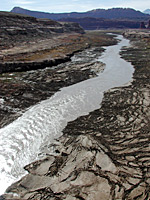Summary
 |
|
The Colorado River emerges from beneath the Hite bridge. |
It's not a matter of if, but when, the Colorado River plumbing system will
collapse. Water supply and power generation for metropolitan areas from Los
Angeles to Denver will be affected, as well as the region's multi-billion
dollar agricultural industry. The sixty million acre-feet of water that can
be stored in the basin's reservoirs provide a cushion in times of moderate
reductions in river flows, but as is presently being experienced, are no
match for a sustained drought.
Since 1998, flows in the Colorado River watershed
have been well below normal. Historically, Colorado River flows
average 13.5 million acre feet per year. Over the past four,
they have averaged only 6.9 million acre feet. Reservoirs are
at their lowest level in history and dropping at a rate of
ten percent per year. With below average precipitation again
this year, reservoir levels will continue to decline.
Last year the US Geological Survey warned that
the Colorado Plateau should be prepared for several decades
of below normal river flows, and of "severe or catastrophic
consequences" should the region experience a repeat of the
1942-1977 drought. Recent flows are in fact 15 percent lower
than they were when the 1942 drought began.
Despite the likelihood of a major water shortage
on the horizon, federal and state water managers continue to
keep their heads in the sand.
Living Rivers is working on a two-part program
to reform how Colorado River water is managed, so that even
in years of sustained drought, human needs can be sufficiently
met with water left over to maintain flows for critical riparian
habitat.
We are demanding that the federal government
respond to this crisis and commence a dialogue with the Colorado
River basin states of Arizona, California, Colorado, Nevada,
New Mexico, Utah and Wyoming, and Mexico to revise the outdated
1922 formula for allocating Colorado River Water. Known as
the Colorado River Compact, this flawed agreement gives away
more water on paper than the river historically delivers.
We are also demanding that the federal government
establish water use and efficiency standards for all irrigators
that receive water from subsidized federal water projects.
Irrigators use roughly 75 percent of Colorado River water,
much of it for water intensive crops such as alfalfa and other
feed crops for cattle. Federal programs to facilitate substitution
of vegetable and other crops could save half the water currently
being used for irrigation.
|


